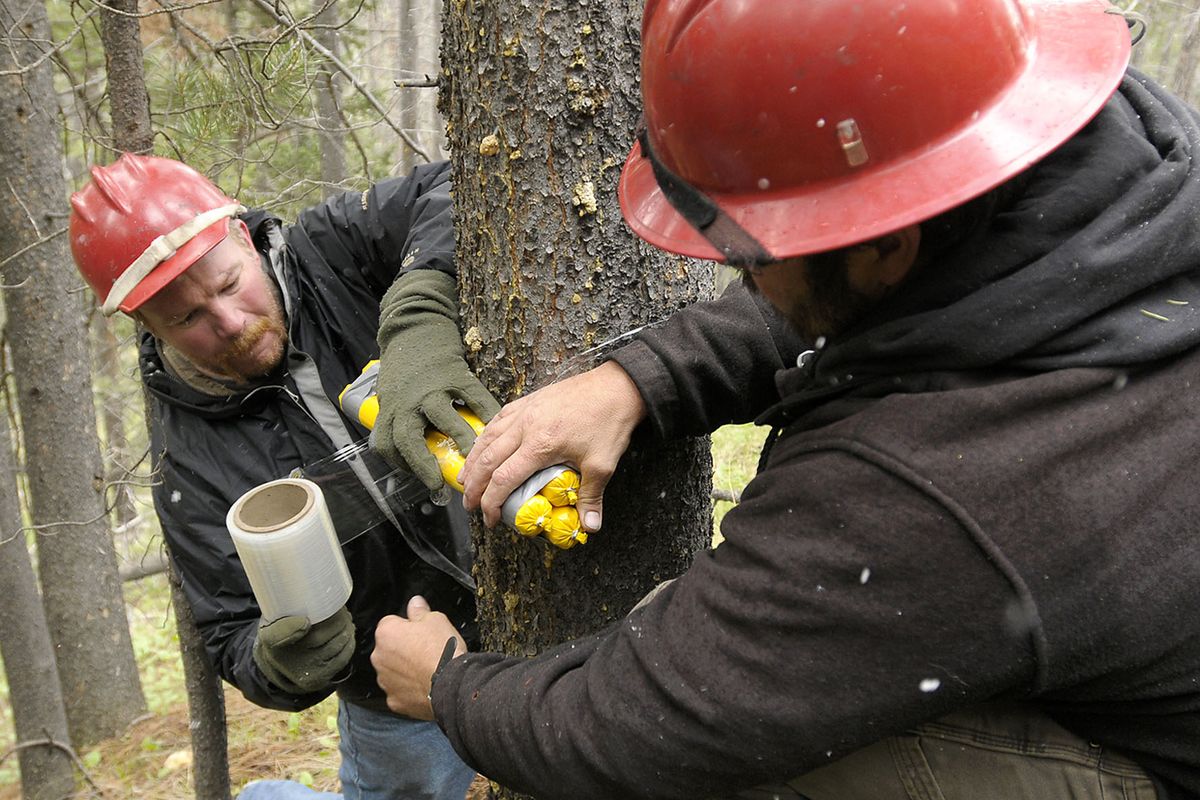Crews use explosives to fell trees
Blasting is easier, safer, experts say

ELLISTON, Mont. – A day’s worth of logging took place in less than a second on a hillside above Hahn Creek.
“This is the most enjoyable part of the job,” Helena National Forest lead blaster Don Senn said as he inspected the parallel lines of toppled trees. “The day goes quickly when you’re concentrating on what you’re doing.”
Concentration was evident in the care Senn’s crew applied to distributing about 100 pounds of explosive sticks among 37 dead pine trees that threatened a stretch of Hahn Creek Road. Once everything was in place, everyone moved 1,000 feet up the road and watched Senn pick up the Rolhenburler detonator box.
“We call it the ‘Rottweiler,”’ joked Dennis Davis, a Missoula Technology Development Center blasting engineer. After two warnings, Senn yelled “Blasting now!” and a loud bang rocked everyone on their heels. A cloud of white smoke rose from the forest.
The emulsion-based explosive is more compact than the fertilizer bombs excavators use, and cheaper than the plastic explosives the military likes. Each stick weighs 1 pound. A six-inch tree takes two sticks. A 10-incher may need four or five.
“We can shoot bullets into this stuff all day long and it won’t go off,” Davis said. Instead of a fuse, the blasters dangle pigtails of detonation cord from each charge and tie them with a double half-hitch knot to a main cord. That cord will only explode when triggered by a specific blasting cap. In turn, it fires the charges. The whole process happens at 26,000 feet per second.
That interval can change a bit. Triggering all the charges at once results in a high-pitched “crack.” Adding a tiny interval between some detonations makes the blast sound more like rolling thunder.
“We learned that from the miners,” Davis said. “You can lower the sound impact on neighbors. We were blasting one time in the Ninemile, and a herd of about 15 elk were grazing nearby. When it went off, I think one might have looked up.”
The decision to blast instead of saw has lots of factors. Wednesday’s project took out 37 trees with a crew of five working about 2 hours. It would take a single chain saw operator about 10 hours to do the same job, given the steep terrain and lack of maneuvering room for more co-workers. So the labor costs are roughly equal, although explosives make an added supply expense.
But the Hahn Creek job also stood right next to a rivulet that made much of a sawyer’s escape route boggy and dangerous. A blasting crew can methodically set up tree after tree and then leave the area when it’s time for action.
Trees that have snapped midway up the trunk, or lost part of their roothold, or have tipped and tangled into surrounding timber, all may be too unsafe for a sawyer to tackle. A blaster can place a charge without ever moving the suspect tree.
“That grove makes you feel really uneasy,” Davis said of the beetle-killed trees. “Fire-killed trees keep their roots up to 10 years. But with beetles, after a few years, the root ball is nonexistent. A strong wind can bring them down.”
All but one of the trees in Wednesday’s blast fell as planned. The holdout hung up on another tree, listing at a 30-degree angle. That made it a perfect candidate for another characteristic of explosives, according to Bob Beckley, another MTDC engineer. While the first charge snapped trees at the base, a different placement could lift the leaner and shake it free from its hanging branches.
“Explosives are a wonderful tool in the toolbox,” Beckley said. “They’ll do anything you want.”
Helena National Forest spokeswoman Lori Wood said any private company with licensed professional blasters can take on hazard-tree clearing jobs, and a few have done so. A recent project in the Pioneer Mountains was put out for bid but got no takers, so U.S. Forest Service blasters used it to test demolition methods and expenses.
Some places don’t allow any other tactic. Davis recalled a tree that fell across a popular whitewater corridor on an Idaho river. There was no safe position for a chain saw operator to reach. But blasters could lower themselves to the log with ropes, attach their charges, and blow the hazard away.
“Otherwise, we would have had to wait for the next spring runoff to push it away,” Davis said. “There are lots of situations where you ask ‘Why put a sawyer under there?’ You light the charge, blow the butt out of it and it drops right down.”